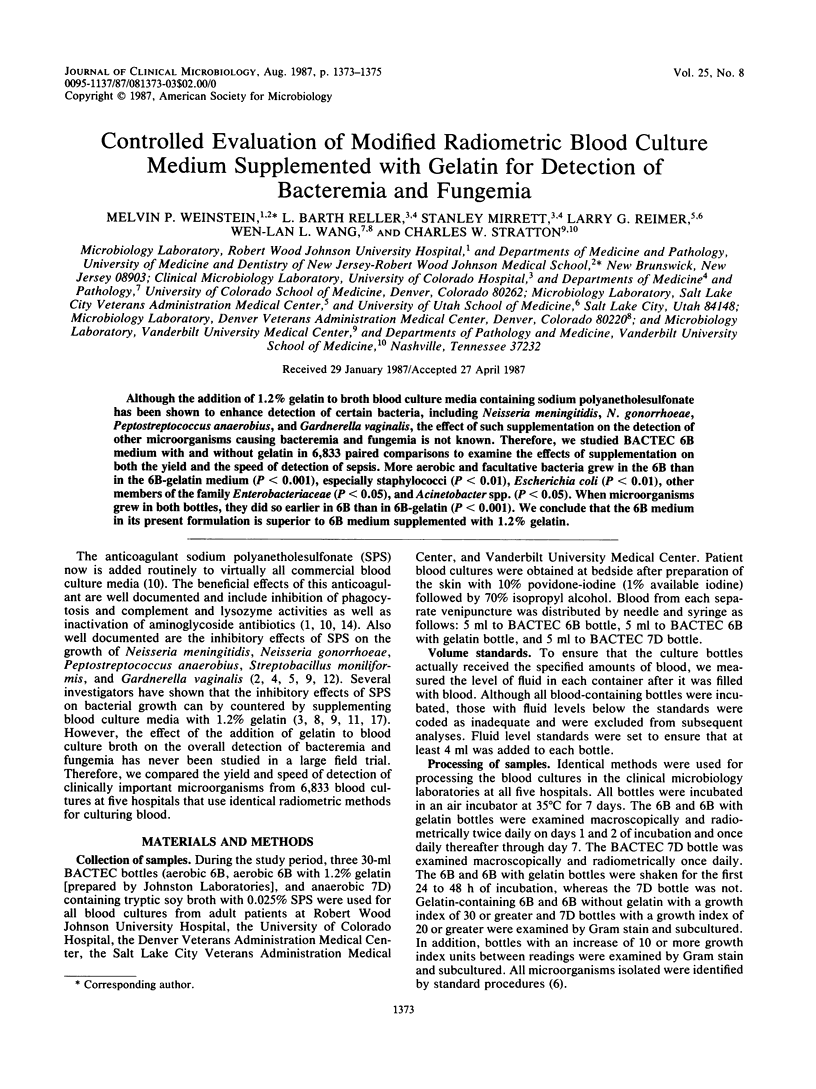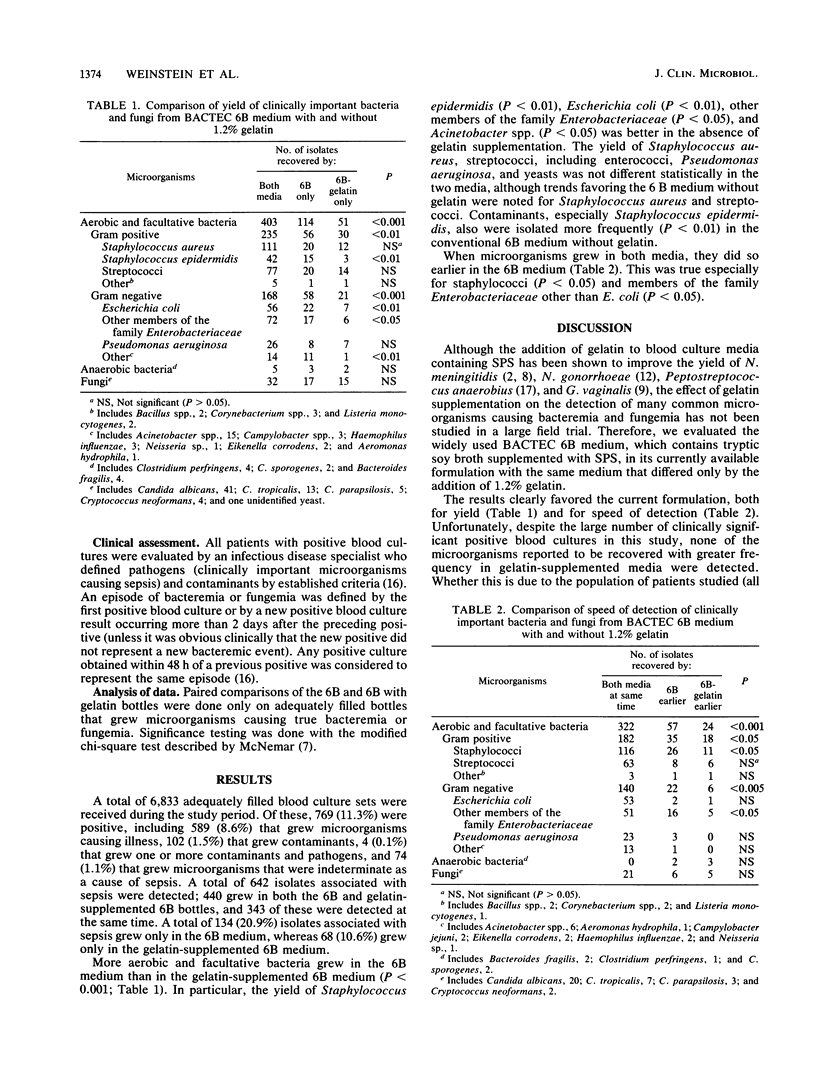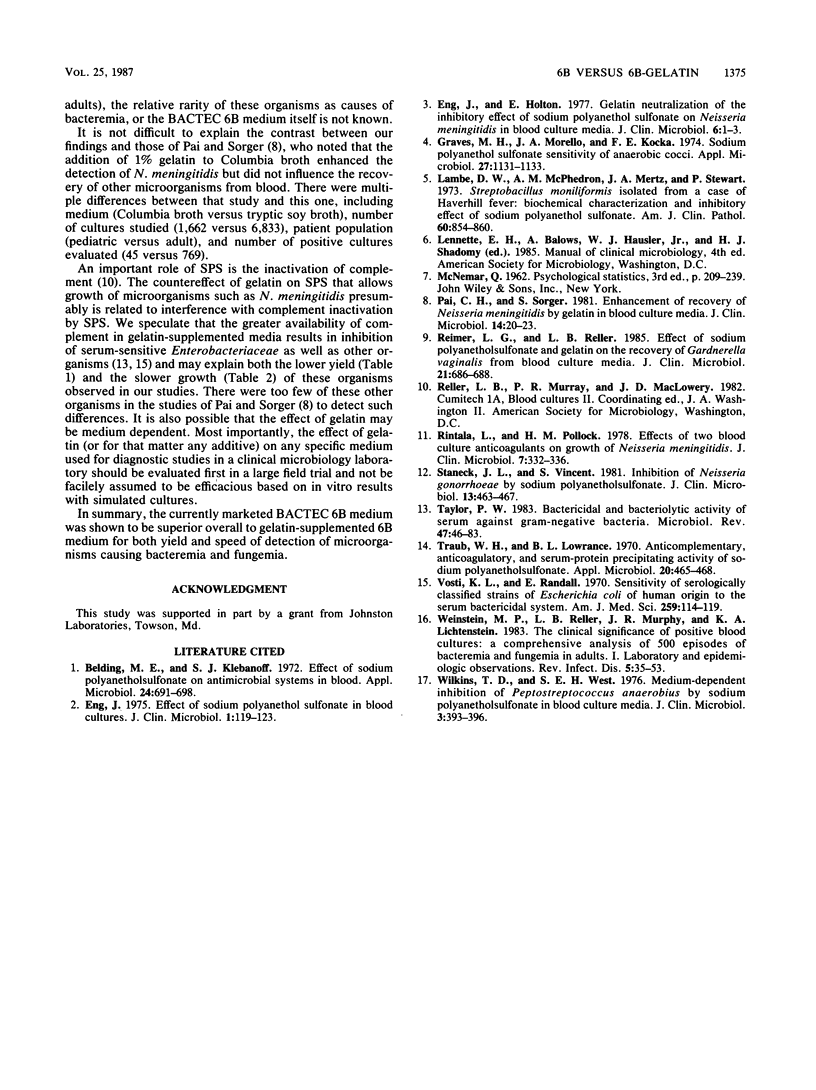Abstract
Although the addition of 1.2% gelatin to broth blood culture media containing sodium polyanetholesulfonate has been shown to enhance detection of certain bacteria, including Neisseria meningitidis, N. gonorrhoeae, Peptostreptococcus anaerobius, and Gardnerella vaginalis, the effect of such supplementation on the detection of other microorganisms causing bacteremia and fungemia is not known. Therefore, we studied BACTEC 6B medium with and without gelatin in 6,833 paired comparisons to examine the effects of supplementation on both the yield and the speed of detection of sepsis. More aerobic and facultative bacteria grew in the 6B than in the 6B-gelatin medium (P less than 0.001), especially staphylococci (P less than 0.01), Escherichia coli (P less than 0.01), other members of the family Enterobacteriaceae (P less than 0.05), and Acinetobacter spp. (P less than 0.05). When microorganisms grew in both bottles, they did so earlier in 6B than in 6B-gelatin (P less than 0.001). We conclude that the 6B medium in its present formulation is superior to 6B medium supplemented with 1.2% gelatin.
Full text
PDF


Selected References
These references are in PubMed. This may not be the complete list of references from this article.
- Belding M. E., Klebanoff S. J. Effect of sodium polyanetholesulfonate on antimicrobial systems in blood. Appl Microbiol. 1972 Nov;24(5):691–698. doi: 10.1128/am.24.5.691-698.1972. [DOI] [PMC free article] [PubMed] [Google Scholar]
- Eng J. Effect of sodium polyanethol sulfonate in blood cultures. J Clin Microbiol. 1975 Feb;1(2):119–123. doi: 10.1128/jcm.1.2.119-123.1975. [DOI] [PMC free article] [PubMed] [Google Scholar]
- Eng J., Holten E. Gelatin neutralization of the inhibitory effect of sodium polyanethol sulfonate on Neisseria meningitidis in blood culture media. J Clin Microbiol. 1977 Jul;6(1):1–3. doi: 10.1128/jcm.6.1.1-3.1977. [DOI] [PMC free article] [PubMed] [Google Scholar]
- Graves M. H., Morello J. A., Kocka F. E. Sodium polyanethol sulfonate sensitivity of anaerobic cocci. Appl Microbiol. 1974 Jun;27(6):1131–1133. doi: 10.1128/am.27.6.1131-1133.1974. [DOI] [PMC free article] [PubMed] [Google Scholar]
- Lambe D. W., Jr, McPhedran A. M., Mertz J. A., Stewart P. Streptobacillus moniliformis isolated from a case of Haverhill fever: biochemical characterization and inhibitory effect of sodium polyanethol sulfonate. Am J Clin Pathol. 1973 Dec;60(6):854–860. doi: 10.1093/ajcp/60.6.854. [DOI] [PubMed] [Google Scholar]
- Pai C. H., Sorger S. Enhancement of recovery of Neisseria meningitidis by gelatin in blood culture media. J Clin Microbiol. 1981 Jul;14(1):20–23. doi: 10.1128/jcm.14.1.20-23.1981. [DOI] [PMC free article] [PubMed] [Google Scholar]
- Reimer L. G., Reller L. B. Effect of sodium polyanetholesulfonate and gelatin on the recovery of Gardnerella vaginalis from blood culture media. J Clin Microbiol. 1985 May;21(5):686–688. doi: 10.1128/jcm.21.5.686-688.1985. [DOI] [PMC free article] [PubMed] [Google Scholar]
- Rintala L., Pollock H. M. Effects of two blood culture anticoagulants on growth of Neisseria meningitidis. J Clin Microbiol. 1978 Apr;7(4):332–336. doi: 10.1128/jcm.7.4.332-336.1978. [DOI] [PMC free article] [PubMed] [Google Scholar]
- Staneck J. L., Vincent S. Inhibition of Neisseria gonorrhoeae by sodium polyanetholesulfonate. J Clin Microbiol. 1981 Mar;13(3):463–467. doi: 10.1128/jcm.13.3.463-467.1981. [DOI] [PMC free article] [PubMed] [Google Scholar]
- Taylor P. W. Bactericidal and bacteriolytic activity of serum against gram-negative bacteria. Microbiol Rev. 1983 Mar;47(1):46–83. doi: 10.1128/mr.47.1.46-83.1983. [DOI] [PMC free article] [PubMed] [Google Scholar]
- Traub W. H., Lowrance B. L. Anticomplementary, anticoagulatory, and serum-protein precipitating activity of sodium polyanetholsulfonate. Appl Microbiol. 1970 Sep;20(3):465–468. doi: 10.1128/am.20.3.465-468.1970. [DOI] [PMC free article] [PubMed] [Google Scholar]
- Vosti K. L., Randall E. Sensitivity of serologically classified strains of escherichia coli of human origin to the serum bactericidal system. Am J Med Sci. 1970 Feb;259(2):114–119. doi: 10.1097/00000441-197002000-00005. [DOI] [PubMed] [Google Scholar]
- Weinstein M. P., Reller L. B., Murphy J. R., Lichtenstein K. A. The clinical significance of positive blood cultures: a comprehensive analysis of 500 episodes of bacteremia and fungemia in adults. I. Laboratory and epidemiologic observations. Rev Infect Dis. 1983 Jan-Feb;5(1):35–53. doi: 10.1093/clinids/5.1.35. [DOI] [PubMed] [Google Scholar]
- Wilkins T. D., West S. E. Medium-dependent inhibition of Peptostreptococcus anaerobius by sodium polyanetholsulfonate in blood culture media. J Clin Microbiol. 1976 Apr;3(4):393–396. doi: 10.1128/jcm.3.4.393-396.1976. [DOI] [PMC free article] [PubMed] [Google Scholar]


